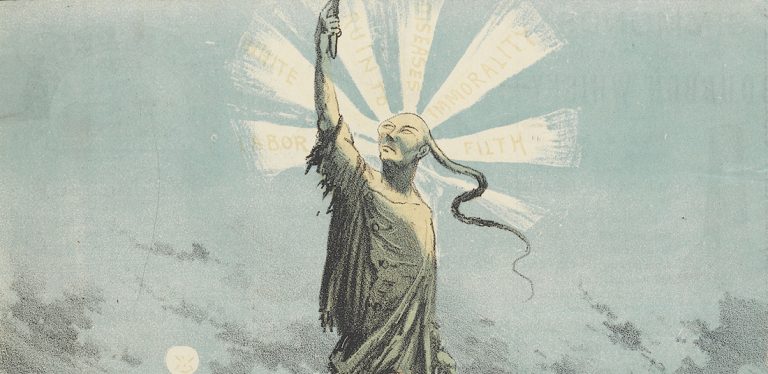
Asian American Educational Services highlights devastating impact of 19th century anti-immigrant legislation on citizenship rights
New York, N.Y. – A comprehensive educational resource from Asian American Educational Services reveals how the Chinese Exclusion Act of 1882 and related legislation created a devastating precedent for race-based immigration restrictions that continues to influence modern immigration policy and anti-Asian sentiment in America.
The educational materials, designed for grades 7-10, examine how Chinese immigrants who initially arrived in the early 1800s to fulfill America’s need for cheap labor soon became targets of systematic exclusion through federal legislation explicitly designed to limit immigration based on race.
The Foundation of Exclusion
According to the educational resource, Chinese immigrants first arrived in the United States seeking economic opportunities while fleeing poverty and famine in China. “At first the Chinese were welcomed as cheap labor used to fulfill the idea of ‘manifest destiny’ held by many white Americans at the time,” the materials explain. The Burlingame Treaty of 1868 between China and the U.S. initially allowed Chinese workers to enter freely to ensure what the treaty called “a sufficient supply of Chinese labor.”
However, the educational materials document how attitudes shifted dramatically during the 1870s when economic panic and unemployment created resentment among white workers. “Labor unions of white workers formed and began to see the Chinese workers as competition,” the resource states, leading to widespread violence against Chinese communities.
The materials describe how “gangs would roam through the streets, go to Chinatown, and assault people. They would attack Chinese businesses and burn them down. There were riots, lynchings, burnings, and massacres of Chinese people.”
Legislative Weaponization of Racism
The educational content traces how anti-Chinese sentiment was codified into federal law, beginning with the Page Act of 1875, signed by President Ulysses S. Grant. This legislation marked the end of America’s open immigration policy and specifically targeted Chinese women, who were all assumed to be “immoral.” The act prevented Chinese men from forming families in the U.S. and created what the materials describe as “bachelor societies” among Chinese male populations.
The Chinese Exclusion Act, signed on May 6, 1882, by President Chester Arthur, represented the culmination of this anti-immigrant fervor. The law explicitly stated: “The coming of Chinese laborers to the United States be, and the same is hereby, suspended; and during such suspension it shall not be lawful for any Chinese laborers to come.”
Voices of Opposition
The educational materials highlight that despite overwhelming anti-Chinese sentiment, some prominent figures advocated for Chinese immigration rights. Frederick Douglass, the African American abolitionist and statesman, emerged as a notable supporter of Chinese immigration rights, speaking “not only in favor of Chinese immigration, and migration more broadly, but also in favor of allowing immigrants to gain citizenship, the right to vote, and hold public office.”
However, such voices were overshadowed by the dominant anti-Chinese narrative, exemplified by political slogans like “The Chinese Must Go” and California politician Denis Kearney‘s declaration that “California must be all American or all Chinese. We are resolved that it shall be American, and are prepared to make it so.”
Lasting Impact on Civil Rights
The educational resource emphasizes how these exclusion laws extended far beyond immigration, creating a comprehensive system of discrimination. “Racist laws and practices forbade Asians from marrying white people, attending white schools, living in certain parts of cities, testifying in court against white people, owning land and property, and holding commercial and professional licenses,” the materials document.
The Alien Land Laws specifically targeted “aliens ineligible for citizenship” from owning or leasing land, directly targeting Asian immigrants. These policies, according to the educational content, “upheld white supremacy by excluding communities of color and made it difficult for them to gain financial security, electoral power, and long-term stability in the U.S.”
Modern Relevance

The educational materials connect these historical exclusion laws to contemporary issues, noting that the Chinese Exclusion Act was eventually repealed in 1943 when the U.S. sought to build alliance with China against Japan during World War II.
However, the discriminatory framework established by these laws was later applied to Japanese Americans during their forced incarceration.
The resource concludes by emphasizing that “Asian Pacific Islander Desi American (APIDA) communities are still targets of exclusion, marginalization, and discrimination” today, making these historical lessons particularly relevant for understanding contemporary anti-Asian sentiment and immigration debates.
The educational materials serve as a stark reminder of how legislative exclusion based on race and nationality can become institutionalized, creating lasting impacts on civil rights and American society.
As the resource demonstrates, understanding this history is crucial for recognizing how patterns of exclusion continue to influence modern immigration policy and community relations.